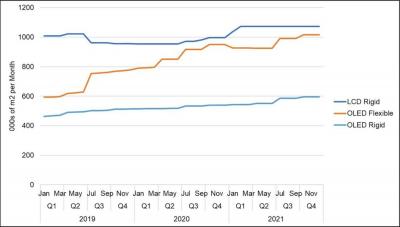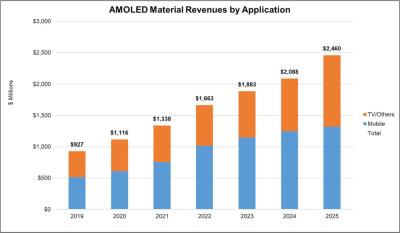 TCL China Star Optoelectronics Technology (CSOT, also called Shenzhen Huaxing Photoelectric Technology) is a China based display producer (owned by TCL, Century Science & Technology Investment and Samsung Display). The company is producing both LCDs and OLED displays.
TCL China Star Optoelectronics Technology (CSOT, also called Shenzhen Huaxing Photoelectric Technology) is a China based display producer (owned by TCL, Century Science & Technology Investment and Samsung Display). The company is producing both LCDs and OLED displays.
CSoT started developing OLED technologies back in 2012. In 2013 it was reported that CSOT will invest over $4 billion to build a 8.5-Gen Oxide-TFT LCD+OLED TV fab, but that did not materialize. In 2017 CSoT started to construct a 6-Gen LTPS flexible AMOLED production line in Wuhan, China, in a $5.08 billion investment. CSoT is now producing mobile AMOLED displays at that fab, and is developing high-end technologies, including LTPO, microlens arrays and polarizer-free OLEDs.
CSoT is very active with inkjet printing technologies, and is aiming to start mass production of OLED TV panels by 2024. Over the years the company presented impressive prototypes of printed panels.
No.5 FuHong Road
FuTian
ShenZhen
China
TCL shows a 14-inch inkjet-printed rollable OLED display
Yesterday we reported that during its DTC 2021 conference, TCL demonstrated a 65" inkjet-printed 8K OLED panel co-developed by TCL's CSoT and JOLED. During the conference, the company also unveiled another panel a rollable OLED.
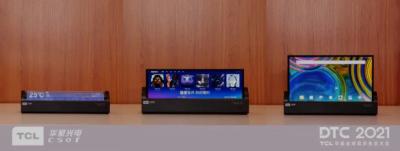
This is a 14" inkjet printed OLED panel, produced using an inkjet printing process.
TCL developed a 65" 8K inkjet printed OLED TV display, as it gets ready for mass production in 2023
According to a report from China, TCL demonstrated 65" 8K OLED panel, produced using an inkjet printing process. This display was co-developed by TCL's CSoT and JOLED.
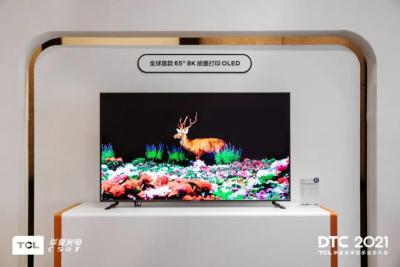
Last year it was reported that TCL's CSoT is building a $6.8 billion 8.5-Gen inkjet printing line in Guangzhou (the T8 line), with production expected to begin in 2023.
Reports from Korea suggest that BOE and CSoT are looking to establish 8-Gen AMOLED fabs
As demand for larger mobile OLED displays, for laptops, tablets and monitors is on the rise, there are reports that Samsung Display is considering building a 8.5-Gen AMOLED fab dedicated for laptop and IT displays. SDC is developing technologies to overcome the limitation in OLED deposition.
According to a new report from Korea, China's BOE and CSoT are both looking to also establish 8-Gen OLED production lines. BOE is accelerating its plans for a 2200x2500 (8-Gen) OLED deposition line, and is developing deposition technologies towards that goal. BOE's main target is to produce smartphone OLED displays, which it hopes to supply to Apple.
DSCC: Inkjet printing of emitters and color conversion layers for OLED displays to reach 7.1 million sqm by 2025
DSCC says that inkjet printing technologies for OLED display production is finally starting to gain traction, and the company sees IJP OLED display capacity to increase in a 137% CAGR from 2020 to 2025, to reach 7.1 million sqm.
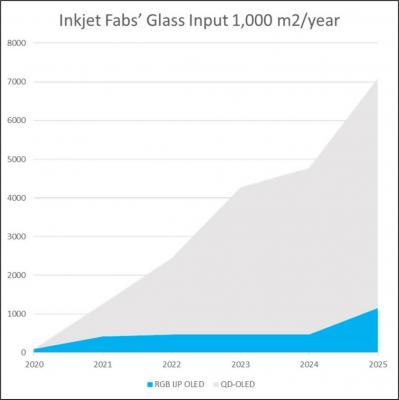
As you can see from the chart, most of the growth will come from the printing of the quantum-dots color conversion layers in Samsung's QD-OLED fabs. Actual RGB inkjet printing will be confined to JOLED's fab which will start mass producing in 2021. In 2024, China Star (CSoT) will begin printing OLED TV panels at its T8 line.
OLED production will grow 94% in Q2 2021, as demand for OLED panels increases
DSCC says that OLED production will grow 94% in the Q2 2021, fueled by strong demand for OLED in smartphones, TVs and other devices - coupled with a recovery from the pandemic. Growth in OLED input area for small & medium displays is expected to grow 68%, while grow in OLED TV input area will grow by 134% over last year.
The chart above shows the total OLED (and mobile LCD) industry capacity. As you can see, flexible OLED capacity is growing - mainly from expansions by CSoT, Tianma and Visionox. There's also growth in rigid OLED capacity - from Everdisplay and JOLED.
TCL shows a smartphone concept that includes a rollable and foldable OLED display
Chinese smartphone producer TCL unveiled an interesting new smartphone prototype (concept?) called the Fold ‘n’ Roll.
As you can see in the video, the device has a 6.87-inch OLED display when fully folded. It can open up (out-folding) into a 8.85-inch display, and then it can open even further to a 10-inch tablet-like device using a rolling mechanism. The display itself is produced by TCL's CSoT subsidiary.
TCL plans to start producing OLED TV panels by 2023, using an inkjet printing process
TCL said in a recent press conference that the company plans to start producing OLED TV panels in 2023. These OLED panels will be printed using an inkjet printing process.
TCL has been a long time believer in inkjet printing for OLED displays, and the company has established Juhua Printing in 2016 (together with Tianma and other collaborators) as an "open-innovation platform" to develop ink-jet printing of OLED panels. In 2020 TCL invested $187 million USD in Japan's inkjet printing developer and producer JOLED, and has also signed an agreement to jointly develop OLED TV printing technologies.
The Elec: Samsung Display is developing foldable OLEDs for Google, Xiaomi and Oppo
Korea's The Elec says that it has learned that Samsung display is developing in-folding OLED displays for Google, Xiaomi and Oppo.

Xiaomi, who has in the past shown prototypes that use Visionox out-folding displays, is now aiming to adopt an SDC in-folding display - 8.03" in size. The Elec says that the same phone will use a large 6.38-inch external display, which will be produced by both SDC CSoT.
DSCC posts its latest outlook for the OLED materials market
DSCC posted an interesting post with its latest views and forecasts on the OLED material market. The company expects AMOLED stack material sales to grow at a 18% CAGR in the next five years, from $294 million in 2019 to $2.46 billion in 2024. Compared to its previous estimate, DSCC sees higher sales as demand for OLED TVs and OLEDs in the IT market (tablets and notebooks) is increasing.
DSCC also posted an analysis of LGD's new evo OLED material stack. Compared to LGD's "standard" WOLED stack, the evo adds an emitting green layer to improve the brightness by 20%. This of course adds an extra material cost to the panel price.
TCL / CSoT shows its rollable AMOLED displays at CES 2021
In October 2020 TCL's CSoT demonstrated some new rollable OLED technologies, and today at CES the company published this nice video you see below that again demonstrates new rollable OLEDs:
TCL first shows a rollable smartphone, that uses a 7.8-inch AMOLED that rolls into a 6.7-inch one. The display features a bending radius of 3 mm and CSoT says it can withstand up to 100,000 sliding cycles.
Pagination
- Previous page
- Page 3
- Next page


